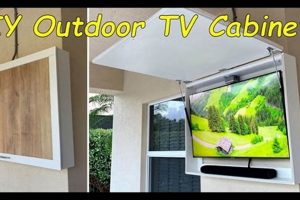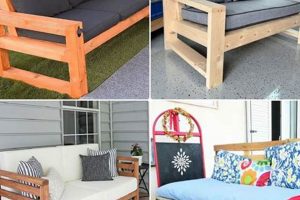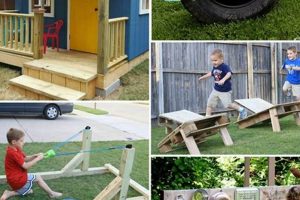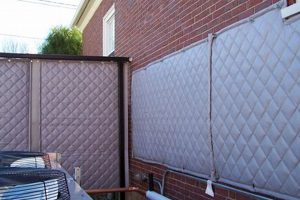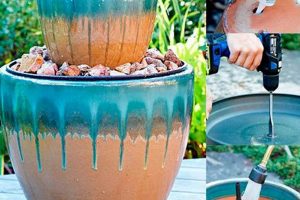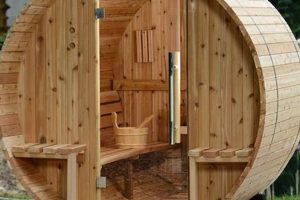A self-constructed, open-air enclosure designed to house rabbits, providing shelter from the elements and protection from predators, represents a significant undertaking for pet owners. Such a structure, typically built with readily available materials like wood, wire mesh, and roofing, allows for customization to suit individual needs and spatial constraints. For example, the size, layout, and inclusion of features such as multiple levels or integrated runs can be tailored during its construction.
The construction of a housing unit for rabbits offers benefits that extend beyond mere cost savings. It provides the opportunity to create a customized habitat optimized for the specific climate and potential threats in the location. Historically, providing secure and comfortable housing for domestic animals has been a key element in responsible animal stewardship, reflecting a long-standing relationship between humans and the animals they care for. This construction activity allows for direct control over materials used, fostering a greater sense of connection and responsibility towards the animal’s welfare.
The subsequent sections will elaborate on key considerations in the design and building processes, including material selection, structural integrity, predator-proofing strategies, and best practices for maintaining a sanitary and enriching living environment for the rabbits. This will guide the process of creating a secure and functional habitat.
Essential Considerations for Constructing Rabbit Housing
The following guidelines provide crucial insights for individuals undertaking the creation of a durable and safe open-air environment for rabbits.
Tip 1: Structural Integrity: Prioritize a solid foundation to prevent collapse or instability. Implement robust framing techniques and appropriate joinery methods to ensure long-term structural soundness. Consider soil composition and potential for settling when designing the base.
Tip 2: Predator Protection: Use heavy-gauge wire mesh with small openings to encase the enclosure fully, including the floor. Bury the mesh at least 12 inches deep to deter digging predators. Implement secure latching mechanisms that are difficult for animals to manipulate.
Tip 3: Weather Resistance: Select roofing materials appropriate for the local climate. Overhanging eaves can provide additional protection from rain and sun. Consider insulating portions of the structure for colder climates or providing ample shade during warmer months.
Tip 4: Ventilation: Ensure adequate airflow to prevent the buildup of ammonia and other harmful gases. Incorporate screened vents strategically positioned to promote cross-ventilation without creating drafts.
Tip 5: Material Selection: Opt for untreated lumber or animal-safe preservatives to avoid potential toxicity. Pressure-treated wood should be avoided due to chemical leaching. Consider cedar or redwood for natural rot resistance.
Tip 6: Space Requirements: Adhere to minimum space recommendations based on the breed and number of rabbits. Overcrowding can lead to stress, aggression, and health problems. Provide ample room for exercise and natural behaviors.
Tip 7: Accessibility for Cleaning: Design the structure with easy access points for regular cleaning and maintenance. Removable trays or doors can facilitate waste removal. Regular sanitation is essential for preventing disease.
Adherence to these principles will contribute to the development of a secure, comfortable, and long-lasting dwelling, promoting the health and well-being of the rabbits.
The subsequent section will address essential aspects of ongoing maintenance and enrichment strategies that should be considered following completion of the construction.
1. Durability
Durability, in the context of self-constructed, open-air rabbit housing, is a critical factor that dictates the longevity, safety, and overall value of the structure. A durable enclosure minimizes maintenance, reduces the risk of breaches by predators, and ensures the rabbits have a secure habitat for an extended period.
- Material Selection for Longevity
The choice of materials directly impacts the lifespan of the housing. Utilizing naturally rot-resistant woods like cedar or redwood, or employing treated lumber (ensuring it’s animal-safe) will enhance the structure’s resistance to environmental degradation. Metal components, such as wire mesh, should be galvanized or coated to prevent rust. Conversely, neglecting material selection can lead to premature decay, compromising the integrity of the housing and requiring costly repairs or replacement.
- Structural Design and Joint Integrity
A well-engineered design is essential for distributing weight and withstanding external forces such as wind, snow, and potential impacts. Robust joinery techniques, such as screws and bolts instead of nails, contribute to a stronger framework that resists loosening over time. Reinforcing corners and weak points with metal brackets further enhances structural stability. A poorly designed or inadequately constructed frame will be susceptible to sagging, warping, and eventual collapse.
- Protection Against Environmental Factors
Exposure to the elements significantly affects the durability of an outdoor structure. Proper roofing with appropriate overhangs protects the wood from direct rain and sun exposure. Adequate ventilation prevents moisture buildup and reduces the risk of rot. Applying weather-resistant sealants or paints to exposed surfaces provides an additional layer of protection. Failing to address these factors accelerates the deterioration process, leading to premature failure of the housing.
- Resistance to Animal Activity
Rabbits themselves can contribute to the wear and tear on their housing. Their natural digging and chewing behaviors can damage the structure over time. Reinforcing vulnerable areas with wire mesh or durable materials prevents rabbits from escaping or compromising the integrity of the enclosure. Implementing measures to redirect digging activities away from the housing’s perimeter also extends its lifespan.
In summation, the durability of a self-constructed outdoor rabbit enclosure is a multifaceted attribute that depends on careful consideration of material selection, structural design, environmental protection, and resistance to animal activity. A focus on these aspects translates to a secure, long-lasting habitat, reducing the need for constant upkeep and ensuring the continued safety and comfort of the rabbits.
2. Predator-Proofing
Predator-proofing is an indispensable element in the design and construction of outdoor rabbit housing, directly impacting the safety and survival of the inhabitants. The absence of adequate predator deterrents in a self-constructed hutch can have dire consequences, ranging from injury to fatalities. Numerous predators, including foxes, coyotes, dogs, cats, raccoons, and even birds of prey, pose a threat to rabbits housed outdoors. The construction must, therefore, address these potential dangers proactively. For instance, consider the case of a rural homeowner who built an open-topped enclosure; within a week, a hawk preyed on the rabbits. This illustrates the critical need for a comprehensive approach to security. The effective design will prevent access from above, below, and all sides.
Implementation of predator-proofing measures involves several key strategies. Heavy-gauge wire mesh with small openings is essential for encasing the entire enclosure, including the floor. This prevents predators from digging underneath or reaching through the sides. Burying the mesh at least 12 inches below ground level is a standard practice to deter burrowing predators. Securing the top of the hutch with a solid roof or wire mesh further protects against aerial threats. Latches and closures should be robust and ideally feature a locking mechanism that cannot be easily manipulated by animals. A double-door system for entry and exit can also add a layer of security, preventing accidental escapes during feeding or cleaning. Practical application involves a thorough assessment of the local predator population and adaptation of the enclosure design accordingly.
In conclusion, predator-proofing is not merely an optional feature, but a fundamental requirement for responsible rabbit husbandry. The successful construction of outdoor rabbit housing hinges upon a meticulous approach to security, integrating robust materials and effective design principles. Failure to prioritize predator protection exposes rabbits to significant risk, highlighting the practical significance of this understanding and underscoring the moral obligation to provide a safe and secure environment for these animals.
3. Weather Protection
Weather protection is a critical consideration in the design and construction of self-built outdoor rabbit enclosures. Exposure to the elements can significantly impact the health, comfort, and well-being of rabbits. Therefore, a well-designed structure must mitigate the adverse effects of rain, sun, wind, and extreme temperatures.
- Roofing Material and Design
The selection of roofing materials plays a pivotal role in shielding rabbits from precipitation and excessive sunlight. Overhanging eaves extend protection to the sides of the enclosure, preventing rain from entering and reducing direct sun exposure. Asphalt shingles, metal roofing, or even treated wood are common choices, each with varying degrees of durability and insulation. The roofs pitch should facilitate water runoff, preventing pooling and potential leaks. A poorly designed roof can lead to water damage, mold growth, and temperature extremes within the hutch.
- Windbreaks and Insulation
Exposure to strong winds can create drafts and lower the internal temperature of the housing, particularly during colder months. Solid panels or windbreaks strategically positioned on the sides of the enclosure can mitigate this effect. Insulation, using materials like straw, wood shavings, or specialized insulating boards, can further regulate temperature fluctuations. The degree of insulation required will depend on the local climate and the rabbit’s breed. Inadequate wind protection can lead to hypothermia and increased susceptibility to respiratory illnesses.
- Sun Shade and Ventilation
Rabbits are susceptible to heatstroke, making adequate sun protection paramount. Shade structures, such as awnings or strategically placed trees, can reduce direct sunlight exposure during peak hours. Proper ventilation is equally essential to dissipate heat and prevent the buildup of stagnant air. Wire mesh panels, coupled with a well-ventilated roof, allow for airflow while maintaining security. Insufficient sun protection and ventilation can result in overheating, dehydration, and potentially fatal heatstroke.
- Water Drainage and Dampness Control
Excessive moisture within the enclosure can create an environment conducive to bacterial and fungal growth, increasing the risk of disease. Proper drainage is crucial to prevent water from pooling inside the hutch. Elevating the structure off the ground can improve drainage and air circulation. Regularly cleaning and replacing soiled bedding also helps to control dampness. Neglecting water drainage and dampness control can lead to skin infections, respiratory problems, and a generally unsanitary living environment.
The facets of weather protection described above highlight its significance in creating a suitable outdoor habitat for rabbits. Careful consideration of roofing, windbreaks, sun shade, and drainage ensures a comfortable, safe, and healthy environment, ultimately contributing to the well-being and longevity of the animals.
4. Ventilation
Ventilation within a self-constructed outdoor rabbit enclosure is a critical factor affecting the health and well-being of the animals. Inadequate airflow leads to the accumulation of ammonia from urine and feces, creating a hazardous environment that can cause respiratory distress, eye irritation, and a general weakening of the immune system. The enclosed space, if improperly ventilated, traps moisture, promoting the growth of harmful bacteria and fungi, further contributing to respiratory ailments. A practical example is observable in poorly designed hutches where a strong ammonia odor is noticeable upon approach; rabbits housed in such conditions frequently exhibit symptoms such as sneezing, runny eyes, and labored breathing.
Effective ventilation strategies involve incorporating multiple screened openings strategically positioned to promote cross-ventilation, minimizing drafts. These openings should be placed high and low to facilitate the natural convection of air. The size and number of vents must be calculated based on the hutch’s dimensions and the local climate; warmer regions require more extensive ventilation than cooler areas. Moreover, the hutch’s orientation relative to prevailing winds should be considered to optimize airflow without creating excessive drafts. In cases where natural ventilation is insufficient, particularly in humid climates, the incorporation of small, animal-safe fans can enhance air circulation and mitigate the buildup of harmful gases. Failure to address these considerations can lead to chronic health problems and a reduced lifespan for the rabbits.
In summary, adequate ventilation is not merely an optional element, but a fundamental requirement in the construction of a safe and healthy outdoor rabbit housing. The practical application of ventilation principles, encompassing strategic vent placement, consideration of local climate, and potentially the integration of mechanical assistance, is paramount. Prioritizing ventilation directly mitigates the risks associated with poor air quality, fostering a more comfortable and disease-resistant environment for the rabbits, and promoting their overall well-being.
5. Cleaning Access
Facilitating ease of cleaning is a paramount design consideration in the construction of open-air rabbit housing. Inadequate cleaning access compromises hygiene, leading to the accumulation of waste and increasing the risk of disease. The design should therefore prioritize practical solutions for efficient and regular sanitation.
- Removable Trays and Floors
Incorporating removable trays beneath the main living area simplifies waste removal. These trays, constructed from durable, non-porous materials, collect urine and feces, preventing saturation of the bedding and minimizing odor. Similarly, removable floor panels allow for thorough cleaning of the hutch’s base, eliminating accumulated debris. For example, a hutch with a slatted floor and a pull-out tray underneath allows for daily cleaning with minimal effort, significantly reducing the build-up of unsanitary conditions.
- Hinged Doors and Access Panels
Hinged doors, strategically placed, provide convenient access to all areas of the hutch for cleaning and maintenance. Large access panels on the sides and top allow for easy removal of bedding, scrubbing of surfaces, and inspection of the structure. For instance, a top-hinged roof panel enables effortless access to the entire interior, facilitating thorough cleaning of even hard-to-reach corners. The hinges and latches should be durable and weather-resistant to ensure long-term functionality.
- Sloped Floors and Drainage
Slightly sloped floors direct liquids towards a designated drainage point, preventing pooling and simplifying cleaning. This feature is particularly beneficial in outdoor environments where rain or accidental spills can occur. A small drain at the lowest point allows for the easy flushing of the hutch with water, effectively removing accumulated waste. A design incorporating a gentle slope towards a drain outlet significantly reduces the time and effort required for maintaining a clean and sanitary environment.
- Durable, Non-Porous Materials
The selection of materials plays a crucial role in ease of cleaning. Non-porous surfaces, such as treated wood or plastic sheeting, resist absorption of liquids and odors, making them easier to sanitize. These materials are also less susceptible to bacterial and fungal growth. For example, using a smooth, sealed wood for the interior walls of the hutch allows for easy wiping and disinfection, preventing the build-up of grime and minimizing the risk of disease transmission.
These facets of cleaning access, when integrated into the design of open-air rabbit housing, significantly contribute to maintaining a hygienic environment. The implementation of removable trays, hinged doors, sloped floors, and the selection of durable, non-porous materials collectively facilitate efficient and regular sanitation, minimizing the risk of disease and promoting the health and well-being of the rabbits.
6. Rabbit Safety
Rabbit safety is a core principle in the design and construction of self-built outdoor rabbit enclosures. The absence of appropriate safety measures can expose rabbits to a multitude of hazards, impacting their health, well-being, and longevity. It is, therefore, incumbent upon the constructor to prioritize safety in all aspects of the build.
- Non-Toxic Materials
The selection of construction materials directly impacts the health of rabbits. Rabbits are prone to chewing, and the ingestion of toxic substances can lead to severe illness or death. Untreated lumber, or wood treated with animal-safe preservatives, should be prioritized. Pressure-treated wood, which contains chemicals that can leach into the environment, should be avoided. Similarly, paints, sealants, and adhesives must be carefully chosen to ensure they are non-toxic and safe for animal contact. A real-world example is the use of lead-based paint, which, if ingested by a rabbit, can cause lead poisoning, leading to neurological damage and organ failure. Selecting appropriate materials mitigates this risk.
- Elimination of Sharp Edges and Protrusions
The interior of the enclosure must be free of sharp edges, splinters, and protruding nails or screws. Rabbits can easily injure themselves on these hazards, leading to cuts, abrasions, and potential infections. All edges should be sanded smooth, and any fasteners should be countersunk and covered. Wire mesh should be carefully secured to prevent loose strands from causing injury. A practical illustration of this concern is a poorly constructed hutch where exposed nail heads caused lacerations on a rabbit’s ears, necessitating veterinary intervention and highlighting the importance of meticulous attention to detail during construction.
- Appropriate Wire Mesh Gauge and Spacing
The gauge and spacing of wire mesh used in the enclosure must be carefully considered to prevent injuries and escapes. The mesh should be sturdy enough to withstand chewing and climbing, and the openings should be small enough to prevent rabbits from getting their heads or limbs stuck. A wire gauge that is too thin can easily be broken, allowing rabbits to escape or predators to enter. Conversely, mesh with excessively large openings can trap a rabbit’s foot or leg, leading to fractures or dislocations. Optimal mesh selection strikes a balance between security and the prevention of accidental injuries. A typical example occurs when insufficiently robust wire is used, leading to its failure and a rabbit escaping, exposing it to predators and other environmental dangers.
- Secure and Appropriately Sized Entry/Exit Points
Entry and exit points should be designed to allow rabbits to move freely without the risk of injury or escape. Doors should be appropriately sized to prevent rabbits from becoming trapped or squeezed. Latches must be secure and difficult for rabbits to manipulate. Hinges should be robust and properly aligned to prevent doors from sagging or becoming misaligned. Furthermore, the floor near the entry/exit point should be level to prevent trips and falls. An incident involving a poorly designed doorway where a rabbit became wedged, resulting in a spinal injury, serves as a stark reminder of the importance of careful consideration of these design elements.
These facets of rabbit safety, when integrated into the construction of open-air housing, contribute significantly to a secure environment. The implementation of non-toxic materials, the elimination of sharp edges, appropriate wire mesh, and secure entry points collectively minimizes the risk of injury and illness, promoting health and longevity.
7. Enrichment
Enrichment, in the context of self-constructed outdoor rabbit enclosures, addresses the psychological and behavioral needs of the animals, extending beyond basic provisions of food, water, and shelter. The implementation of appropriate enrichment strategies is essential for promoting mental stimulation, reducing boredom, and encouraging natural behaviors within the confines of a limited space. This aspect of care directly influences the rabbits quality of life and overall well-being.
- Digging Opportunities
Rabbits exhibit a natural instinct to dig, a behavior vital for both physical exercise and mental stimulation. Providing a designated digging area within the hutch, such as a sandpit or a container filled with soil, satisfies this innate need. The absence of digging opportunities can lead to frustration, boredom, and the development of destructive behaviors such as chewing on the hutch structure. A properly constructed digging area is contained, preventing the scattering of soil throughout the enclosure, and allows for easy cleaning and maintenance. For example, a sturdy wooden box filled with pesticide-free soil provides a safe and stimulating digging environment.
- Chewing Provisions
Continuous tooth growth necessitates rabbits have access to appropriate chewing materials to prevent dental problems. Providing a variety of safe chewing options, such as untreated wood blocks, willow branches, or cardboard tubes, satisfies this physiological need and prevents rabbits from chewing on the hutch itself. The chewing materials should be regularly replaced to maintain hygiene and prevent boredom. The availability of diverse chewing options encourages natural gnawing behaviors and promotes dental health. The provision of apple wood branches offers both stimulation and dental care.
- Elevated Platforms and Hideaways
Rabbits are prey animals and benefit from having elevated platforms and hideaways within their enclosure to provide a sense of security and control over their environment. Platforms allow rabbits to observe their surroundings from a higher vantage point, while hideaways offer a safe retreat from perceived threats or unwanted attention. These structures should be appropriately sized and sturdy enough to support the rabbits’ weight. Placing a sturdy wooden box with a small entrance in a corner of the hutch provides a secure hideaway for the rabbit to retreat.
- Foraging Opportunities
Simulating natural foraging behaviors can provide mental stimulation and prevent boredom. Scattering food throughout the hutch, hiding treats in toys, or providing hanging baskets of edible greens encourages rabbits to search for their food, prolonging mealtime and promoting activity. Foraging toys, such as balls with small holes that release treats when rolled, add an element of challenge and entertainment. Scattering a small handful of hay throughout the hutch each day encourages the rabbit to actively search and forage.
The integration of these enrichment strategies into the design and maintenance of self-constructed outdoor rabbit housing promotes animal welfare. The provision of digging opportunities, chewing materials, elevated platforms, and foraging options collectively addresses the psychological and behavioral needs of rabbits, contributing to their overall health, happiness, and longevity within the confines of a limited space. Neglecting these aspects of care can result in boredom, frustration, and the development of abnormal behaviors.
Frequently Asked Questions
The following section addresses common inquiries regarding the construction and maintenance of self-built, open-air rabbit housing, providing essential information for responsible pet ownership.
Question 1: What are the minimum space requirements for a rabbit enclosure?
Minimum space requirements vary based on breed size. A general guideline dictates that the enclosure should allow the rabbit to fully stretch in all directions, stand upright on its hind legs without touching the top, and take at least three hops. Smaller breeds require less space than larger breeds. Overcrowding can lead to stress, aggression, and health problems.
Question 2: How can the hutch be effectively protected from extreme weather conditions?
Weather protection involves multiple strategies. Roofing with sufficient overhang shields the hutch from rain and direct sunlight. Insulation, particularly during colder months, helps regulate temperature. Windbreaks provide protection from drafts. Strategically placed shade structures offer refuge from intense heat. Regular monitoring of temperature and humidity levels within the hutch is advisable.
Question 3: What is the best method for cleaning and disinfecting the enclosure?
Regular cleaning is crucial for maintaining hygiene. Waste should be removed daily. The hutch should be thoroughly cleaned and disinfected at least weekly. Use animal-safe disinfectants, avoiding harsh chemicals. Ensure proper drying after cleaning to prevent the growth of mold and bacteria. Remove and replace soiled bedding frequently.
Question 4: What are the most common predators to consider when constructing the hutch?
Common predators vary based on geographic location. Foxes, coyotes, domestic dogs, cats, raccoons, birds of prey, and snakes are potential threats. The enclosure should be designed to withstand attacks from these predators, using heavy-gauge wire mesh and secure latches. Burying the wire mesh deters digging.
Question 5: How can the risk of disease transmission within the hutch be minimized?
Minimizing disease transmission requires strict hygiene practices. Regularly clean and disinfect the hutch, remove waste promptly, and provide fresh water daily. Prevent overcrowding, as it increases stress and weakens the immune system. Quarantine new rabbits before introducing them to existing ones. Consult a veterinarian for appropriate vaccinations and parasite control.
Question 6: What types of enrichment should be provided to stimulate rabbits in an outdoor hutch?
Enrichment is essential for mental and physical well-being. Provide digging opportunities, chewing materials, elevated platforms, and hideaways. Scatter food to encourage foraging behaviors. Regularly introduce new toys and rotate existing ones to prevent boredom. Social interaction, either with other rabbits or human caregivers, is also beneficial.
These frequently asked questions highlight crucial aspects of responsible rabbit care within a self-constructed outdoor environment. Prioritizing space, weather protection, hygiene, predator protection, disease prevention, and enrichment contributes significantly to the health and well-being of the animals.
The following section will provide a summary of the main points discussed within this guide.
DIY Outdoor Bunny Hutch
This document has explored critical aspects of the diy outdoor bunny hutch, emphasizing the necessity of responsible construction and maintenance. Key considerations encompass durability, predator-proofing, weather protection, ventilation, cleaning access, and rabbit safety. The integration of enrichment strategies is paramount for promoting the psychological and behavioral well-being of the animals.
The successful creation and upkeep of a diy outdoor bunny hutch demand a commitment to prioritizing animal welfare. A failure to adhere to these guidelines compromises the health and safety of the rabbits. Continued education and diligence remain crucial for ensuring a positive and enriching environment for these animals. Therefore, diligent implementation of mentioned factors contributes directly to the health, safety, and overall livelihood of those animals within. Prioritization remains as utmost importance.


